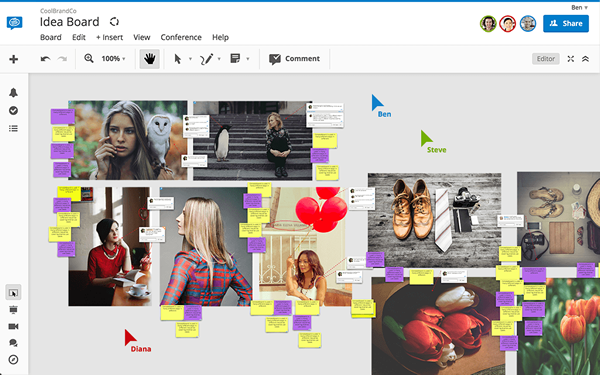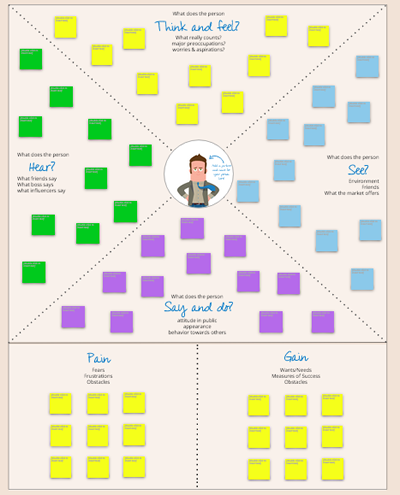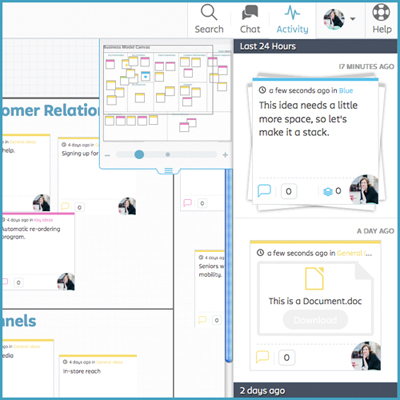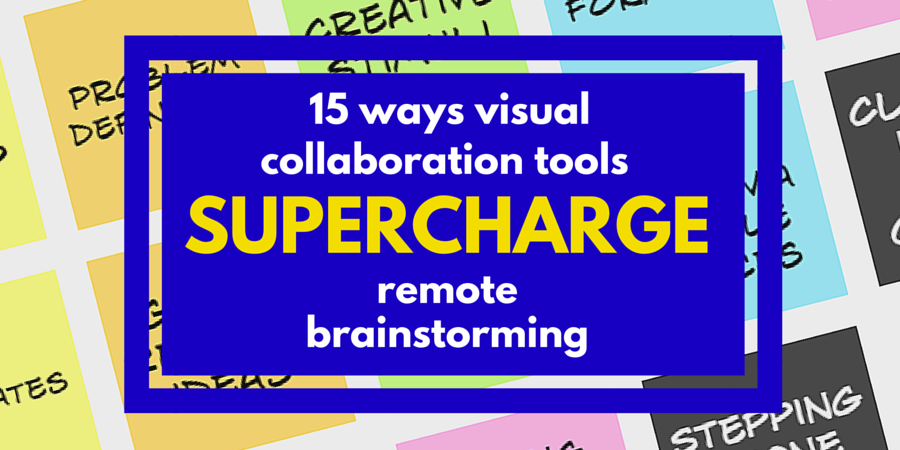When it comes to visual collaboration, a picture is worth far more than a thousand words. It’s worth more like a million.
Whiteboard-based collaboration tools like Mural.ly, ConceptBoard and StormBoard enable remote teams to brainstorm using a combination of words, images, sketches and other multimedia content. This ability to share visual prototypes of ideas helps teams accelerate the co-development of marketing materials, new product development and improvement and a host of other idea-centric business processes.
Here are 15 powerful ways in which visual collaboration tools enhance brainstorming and collaboration:
Warmup
 Brainstorming facilitators can first have team members enter a separate board where they can work on a playful, fun challenge that is unrelated to the problem to be solved. This serves two purposes: It helps team members get familiar with the tool’s collaborative environment and also helps team members get their creative juices flowing before they move on to the actual assignment.
Brainstorming facilitators can first have team members enter a separate board where they can work on a playful, fun challenge that is unrelated to the problem to be solved. This serves two purposes: It helps team members get familiar with the tool’s collaborative environment and also helps team members get their creative juices flowing before they move on to the actual assignment.
Problem definition
2. A section of the board can be reserved for problem definition. The toolsets provided by these tools make it easy to define a rectangular area, give it a different background color and then drag and drop elements from other parts of the board into it.
3. A board can be populated with evocative images or a “visual brief” that serve as catalysts to spur creative thinking.
Brainstorming
 4. Ideas may be submitted in the form of words, images, sketches and other types of content. This diversity of input results in a rich visual canvas that helps spur team members’ thinking to new heights.
4. Ideas may be submitted in the form of words, images, sketches and other types of content. This diversity of input results in a rich visual canvas that helps spur team members’ thinking to new heights.
5. Team members can contribute ideas synchronously (simultaneously) and asynchronously (at different times). That means they can do so when it’s most convenient for them. This is especially valuable when team members work in widely separated time zones.
6. Ideas already placed on the board often serve as stepping stones for additional ideas.
7. Board admins can place background templates – such as four-quadrant diagrams, customer journey maps and a variety of other planning and process oriented tools – in the shared workspace to aid in grouping and classification of ideas.
8. During brainstorming, facilitators can group related ideas together for combination and improvement.
9. Comments can be attached to ideas, enabling team members to ask for clarification of them, to engage in mini-brainstorming conversations to improve specific ideas and more.
10. Support for mobile devices: often, our best ideas come to us when we are away from the workplace. The ability to access your team board any time, anywhere from a mobile device enables you to contribute ideas whenever they strike you, before you forget about them. That’s a big advantage!
Idea evaluation and classification
 11. After brainstorming is complete, the team can vote on ideas and group the most promising ones together for further discussion and consideration. In this way, they can quickly whittle hundreds of ideas down to a handful of the highest-value ones.
11. After brainstorming is complete, the team can vote on ideas and group the most promising ones together for further discussion and consideration. In this way, they can quickly whittle hundreds of ideas down to a handful of the highest-value ones.
12. Visually co-developing ideas can help multi-disciplinary teams quickly build shared understanding and consensus around the best solution or course of action.
13. Colored sticky notes can be used to denote different types of ideas, priorities or to designate the team member who contributed the idea.
Idea implementation
14. The most promising ideas can be transferred to a different board for further development.
15. With some visual collaboration tools, participants can “play back” the group brainstorming process in a time-lapse “movie.” This can reveal how the team’s thinking evolved, and can also be a fast way to onboard new team members. In addition, at a more fundamental level, the board serves as a permanent “artifact” of the brainstorming session and the team’s thinking.


Leave a Reply